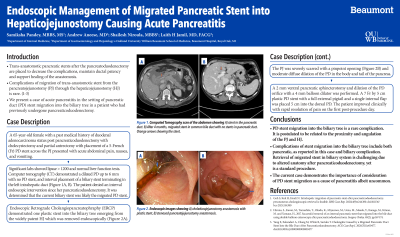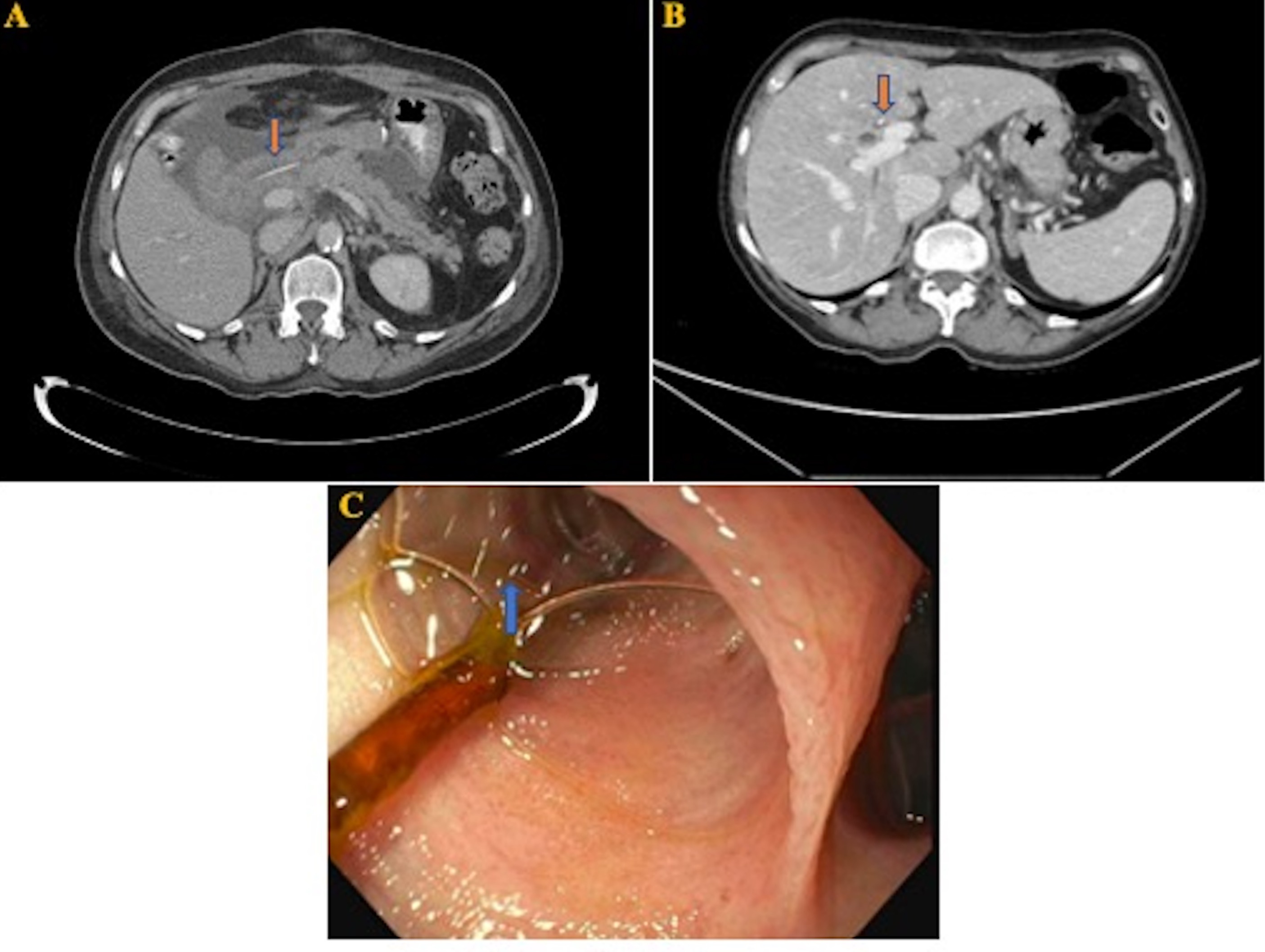Back


Poster Session B - Monday Morning
Category: Biliary/Pancreas
B0054 - Endoscopic Management of Migrated Pancreatic Stent into Hepaticojejunostomy Causing Acute Pancreatitis
Monday, October 24, 2022
10:00 AM – 12:00 PM ET
Location: Crown Ballroom

Has Audio

Samiksha Pandey, MBBS
William Beaumont Hospital
Royal Oak, MI
Presenting Author(s)
Samiksha Pandey, MBBS1, Andrew Aneese, MD2, Shailesh Niroula, MBBS2, Laith Jamil, MD2
1William Beaumont Hospital, Royal Oak, MI; 2Beaumont Health, Royal Oak, MI
Introduction: Trans-anastomotic pancreatic stents after the pancreatoduodenectomy are placed to decrease the complications, maintain ductal patency and support healing of the anastomosis. However, complications of migration of trans-anastomotic stent from the pancreatojejunostomy (PJ) through the hepaticojejunostomy (HJ) is rare.1-3 Here, we present a case of acute pancreatitis in the setting of pancreatic duct (PD) stent migration into the biliary tree in a patient who had previously undergone pancreaticoduodenectomy.
Case Description/Methods: A 65-year-old female with a past medical history of duodenal adenocarcinoma status post pancreaticoduodenectomy with cholecystectomy and partial antrectomy with placement of a 5-French (Fr) PD stent across the PJ presented with acute abdominal pain, nausea, and vomiting. Significant labs showed lipase > 1200 and normal liver function tests. Computer tomography (CT) demonstrated a dilated PD up to 6 mm with no PD stent, and interval placement of a biliary stent terminating in the left intrahepatic duct (Figure 1A, B). The patient denied an interval endoscopic intervention since her pancreaticoduodenectomy. It was determined that the current biliary stent was likely the migrated PD stent. Endoscopic Retrograde Cholangiopancreatophraphy (ERCP) demonstrated one plastic stent into the biliary tree emerging from the widely patent HJ which was removed endoscopically (Figure 1C). The PJ was severely scarred with a pinpoint opening and moderate diffuse dilation of the PD in the body and tail of the pancreas. A 2 mm ventral pancreatic sphincterotomy and dilation of the PD orifice with a 4 mm balloon dilator was performed. A 7 Fr by 5 cm plastic PD stent with a full external pigtail and a single internal flap was placed 5 cm into the dorsal PD. The patient improved clinically with rapid resolution of pain on the first post-procedure day.
Discussion: PD stent migration into the biliary tree is a rare complication. However, it is postulated to be related to the proximity and angulation of the PJ and HJ. Complications of stent migration into the biliary tree include both pancreatic, as reported in this case and biliary complication.3 Retrieval of migrated stent in biliary system is challenging due to altered anatomy after pancreaticoduodenectomy, yet is a standard procedure. The current case demonstrates the importance of consideration of PD stent migration as a cause of pancreatitis albeit uncommon.

Disclosures:
Samiksha Pandey, MBBS1, Andrew Aneese, MD2, Shailesh Niroula, MBBS2, Laith Jamil, MD2. B0054 - Endoscopic Management of Migrated Pancreatic Stent into Hepaticojejunostomy Causing Acute Pancreatitis, ACG 2022 Annual Scientific Meeting Abstracts. Charlotte, NC: American College of Gastroenterology.
1William Beaumont Hospital, Royal Oak, MI; 2Beaumont Health, Royal Oak, MI
Introduction: Trans-anastomotic pancreatic stents after the pancreatoduodenectomy are placed to decrease the complications, maintain ductal patency and support healing of the anastomosis. However, complications of migration of trans-anastomotic stent from the pancreatojejunostomy (PJ) through the hepaticojejunostomy (HJ) is rare.1-3 Here, we present a case of acute pancreatitis in the setting of pancreatic duct (PD) stent migration into the biliary tree in a patient who had previously undergone pancreaticoduodenectomy.
Case Description/Methods: A 65-year-old female with a past medical history of duodenal adenocarcinoma status post pancreaticoduodenectomy with cholecystectomy and partial antrectomy with placement of a 5-French (Fr) PD stent across the PJ presented with acute abdominal pain, nausea, and vomiting. Significant labs showed lipase > 1200 and normal liver function tests. Computer tomography (CT) demonstrated a dilated PD up to 6 mm with no PD stent, and interval placement of a biliary stent terminating in the left intrahepatic duct (Figure 1A, B). The patient denied an interval endoscopic intervention since her pancreaticoduodenectomy. It was determined that the current biliary stent was likely the migrated PD stent. Endoscopic Retrograde Cholangiopancreatophraphy (ERCP) demonstrated one plastic stent into the biliary tree emerging from the widely patent HJ which was removed endoscopically (Figure 1C). The PJ was severely scarred with a pinpoint opening and moderate diffuse dilation of the PD in the body and tail of the pancreas. A 2 mm ventral pancreatic sphincterotomy and dilation of the PD orifice with a 4 mm balloon dilator was performed. A 7 Fr by 5 cm plastic PD stent with a full external pigtail and a single internal flap was placed 5 cm into the dorsal PD. The patient improved clinically with rapid resolution of pain on the first post-procedure day.
Discussion: PD stent migration into the biliary tree is a rare complication. However, it is postulated to be related to the proximity and angulation of the PJ and HJ. Complications of stent migration into the biliary tree include both pancreatic, as reported in this case and biliary complication.3 Retrieval of migrated stent in biliary system is challenging due to altered anatomy after pancreaticoduodenectomy, yet is a standard procedure. The current case demonstrates the importance of consideration of PD stent migration as a cause of pancreatitis albeit uncommon.

Figure: Figure 1: A) Computed Tomography scan of the abdomen showing stent in the pancreatic duct, B) migrated stent in common bile duct with no stents in pancreatic duct after 4 months. C) Endoscopic image showing choledocojejunostomy anastomosis with plastic stent, Orange and blue arrows showing the stent.
Disclosures:
Samiksha Pandey indicated no relevant financial relationships.
Andrew Aneese indicated no relevant financial relationships.
Shailesh Niroula indicated no relevant financial relationships.
Laith Jamil indicated no relevant financial relationships.
Samiksha Pandey, MBBS1, Andrew Aneese, MD2, Shailesh Niroula, MBBS2, Laith Jamil, MD2. B0054 - Endoscopic Management of Migrated Pancreatic Stent into Hepaticojejunostomy Causing Acute Pancreatitis, ACG 2022 Annual Scientific Meeting Abstracts. Charlotte, NC: American College of Gastroenterology.
